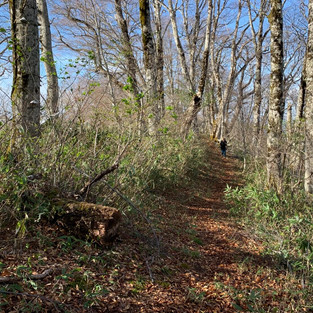Late spring is an amazing time to explore the mountains in Japan, with the emergence of fresh greenery at lower elevations contrasting beautifully against the backdrop of lingering snowfields up high, all complimented by comfortable temperatures and significantly less people on the trail than during the peak summer months. And in our area of Nagano in particular, an added benefit is the incredible abundance of edible mountain plants that pepper the landscape, if you know where to look and what to look for.
The general Japanese term for these plants is 山菜, or sansai, which directly translates to "mountain vegetables". The earliest arrivals begin to appear as soon as the snow recedes, and the sansai season progresses rapidly with the short harvest times for each variety of edibles building, cresting and crashing in quick and fleeting succession like waves upon the landscape. These transient delicacies hold a special place in the heart of the Japanese, not only for the elderly locals in rural areas who forage for them each spring as a way of life, but also for the young housewives in trendy city supermarkets seeking something out of the ordinary to put on the dinner plate... and instagram. Sansai, like sakura (cherry trees), are just another example of the Japan's cultural emphasis on valuing, and celebrating the bittersweet beauty of evanescence.

Otari is known as one of the best locations in all of Japan to go on the hunt for sansai, so much so that signs prohibiting their unauthorized gathering are a permanent fixture of the village scenery. These prohibitions, however, do not apply to locals. More specifically, residents of a specific valley or settlement have the right to gather them in the area in which they live - so last Sunday my friend and mountain mentor Komagata-san and I set out on a day hike up a pair of peaks just down the street - with plenty of extra space left in our backpacks. Though close to home, and not as formidable as the towering Northern Alps standing on the opposite side of the valley, our chosen summits both stood at or above 2,200 m (more than 7,200 ft.) and would make for a great one-day excursion. Despite the warm temperatures in the village below, this time of year the peaks themselves are still covered in a deep blanket of snow and we would need to pack accordingly.

The trailhead is roughly 14 kilometers from our home, but lies on a semi-paved forest road that remains closed except for a brief period of time each summer; simply because the secluded road, built along the side of a mountain, is buried under deep snow in winter and is prone to avalanches, rockslides, landslides, fallen trees and a multitude of other hazards. Though the snow had melted from the surface, the road had yet to be cleared of the freshly fallen rocks and trees carried down the steep slopes above it by the whipping winds, heavy snow, and powerful spring snowmelt since the road was shut to vehicular traffic in the fall. This meant we could drive the first 10 kilometers, but would have to park our car just before the closed gate and start our hike with a 4 km walk on pavement. A slight inconvenience, but one that all but ensured we would have the mountains to ourselves.

The hike along the road was pleasant, and if it weren't for the thick cloud cover dominating the early morning sky at 5:30 a.m., the views along the way would have been incredible. The road itself spans a remote section of northern Nagano and connects the Chubu Sangaku National Park and the Hakuba Valley to the Myoko-Togakushi Renzan National Park. It's a superbly scenic driveway during the summer and fall when car travel is possible, and we were hoping the forecasted clear skies would allow us to enjoy the true beauty of the small section we were passing through. Instead, we were met with fog and light rain, and with the views obscured in clouds, we set a quick pace, stopping only to scope out the locations of several varieties of sansai to collect on the way back, and to nervously laugh at the minutes-fresh pile of bear poop still steaming in the middle of the road.

From the signposts signaling the 1,200m trailhead, and the official start of the hike, the path rose steeply through the fogged-out forest. The monotony of brown decaying leaves beneath our feet was broken intermittently by bursts of purple and pink alpine flowers delicately lining both sides of the trail. We encountered occasional patches of snow not long after, and within an hour and a half of climbing we took the time to attach our crampons for easier travel on the unbroken line of snow occupying the space between us and the summits. Snow travel requires one to read the terrain since paths and other trail markings are hidden from the landscape. On this day, we were also moving without the benefit of following the footsteps of other hikers as is often possible on more popular routes. Furthermore, as we rose higher up the mountain our capacity to survey the scene and scope out a route was being more and more impaired by thickening whiteout fog.
We had maps, compasses and GPS and were able to navigate in general without problem, but occasionally had to take small detours around crevasses, cornices, exposed streams and other impediments that we were unable to see until arriving within meters of them. The fog cleared long enough to reveal fleeting glimpses of surrounding mountains such as Mt. Amakazari, Mt. Kurohime, Mt. Myoko and the massive snowcapped ridge of the Northern Alps, but never for more than a brief moment. While the views weren't what we hoped for, we were lucky enough to spot several kamoshika, or Japanese Serow, and were surprised by a spooked rabbit that bolted past us on the trail inches from our feet as we stopped for some water.

We reached the first summit 4 hours after setting out, cutting two hours off the map time despite a leisurely pace with plentiful pauses for navigation, snacks and sansai scouting. Another 30 minutes later we reached our goal summit. We paused for a brief bite on the cold and windy peak before turning around and retracing our steps, literally, as visibility was still extremely poor and our footprints provided a welcome navigational reference for the return trip.

The hike back was slow and punctuated with breaks to pick the edibles we located on the way up. One of the sansai we encountered, and the most plentiful, is a variety known as ギョウジャニンニク/行者葫 or gyoja ninniku. Gyoja refers to individuals engaged in ascetic training for religious purposes, while ninniku is the Japanese term for garlic. This simple yet descriptive etymology indicates that this particular leafy green edible, with an intense garlic-like scent and taste, was a popular food choice amongst practitioners of mountain worship, such as Shugendo. Rightfully so, as it really does taste great and is found in just the types of places you would want to go to escape humanity, draw closer to nature and eliminate unessential distractions from your life in pursuit of spiritual goals.

While our eyes had been glued to the ground as we scanned our surroundings for the low-lying clusters of gyoja ninniku, now with bags full of the fragrant leaves, our line of sight was redirected higher off the forest floor to the trees and their freshly sprouted leaves. Next we were on the lookout for a rarer treat, fragrant buds known as the "Queen of Sansai" - コシアブラ (koshiabura). Unlike other forest flora, koshiabura is distinguishable most readily due to its tendency to grow as a long, thin singular stalk with very few protruding branches. The edible bits are the young shoots of leaves emerging from the tips of the stalk and/or branches before they have fully opened. The trees themselves are skinny and fragile enough to make climbing them impossible most of the time, so it's necessary to find those that are low enough to be reached from the ground, or go with a partner so that one person can bend the stalk with their body weight while the other snaps the buds from the branch. Most of what we were able to spot was located on steep slopes away from the trail, which only added to the fun of the harvest.

We grabbed enough for our own dinners with a little extra to pass on to our village neighbors who are constantly sharing their own sansai spoils with us. Once back at the forest road, we complimented our hauls with a few other lesser-known varieties growing in plain sight along the side of the road. For each and every mountain vegetable we picked, we carefully did so in sustainable fashion, being sure not to gather too much from a single plant or a particular area. The wonderful thing about a hike like this is that the enjoyment stretches all the way to the dinner table. The satisfaction derived from a meal gathered by your own hands is truly something special, and a memorable experience. Bonus when it also tastes great. If you find yourself in Otari or the greater Nagano area next spring, join us on a sansai hike, and be sure to stay for dinner!






















